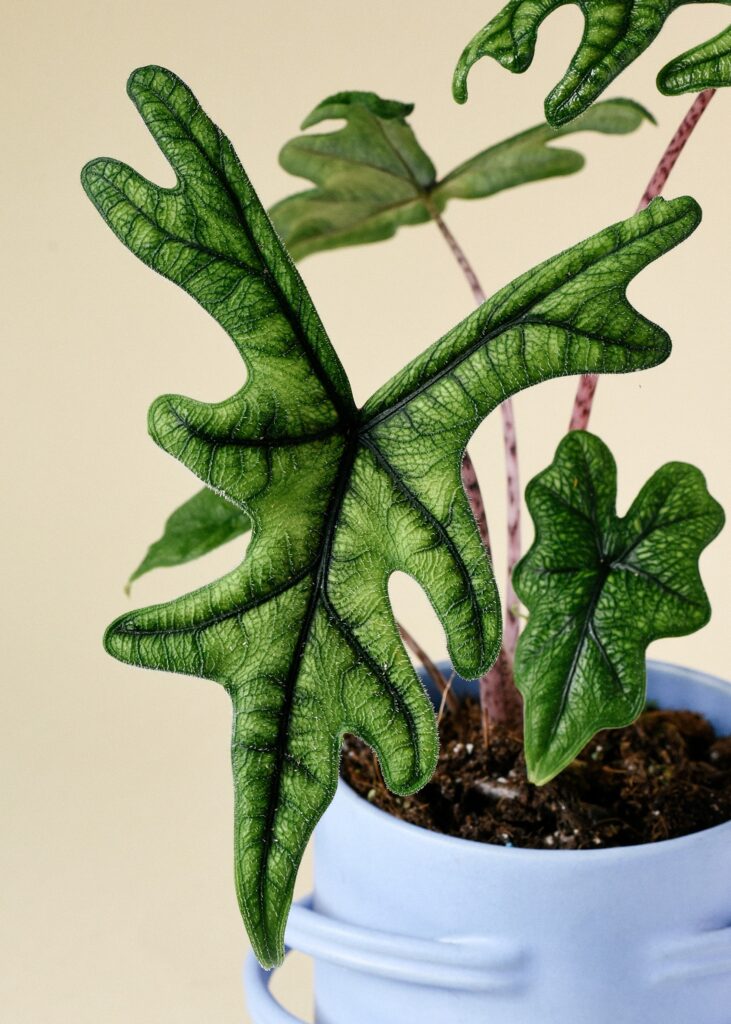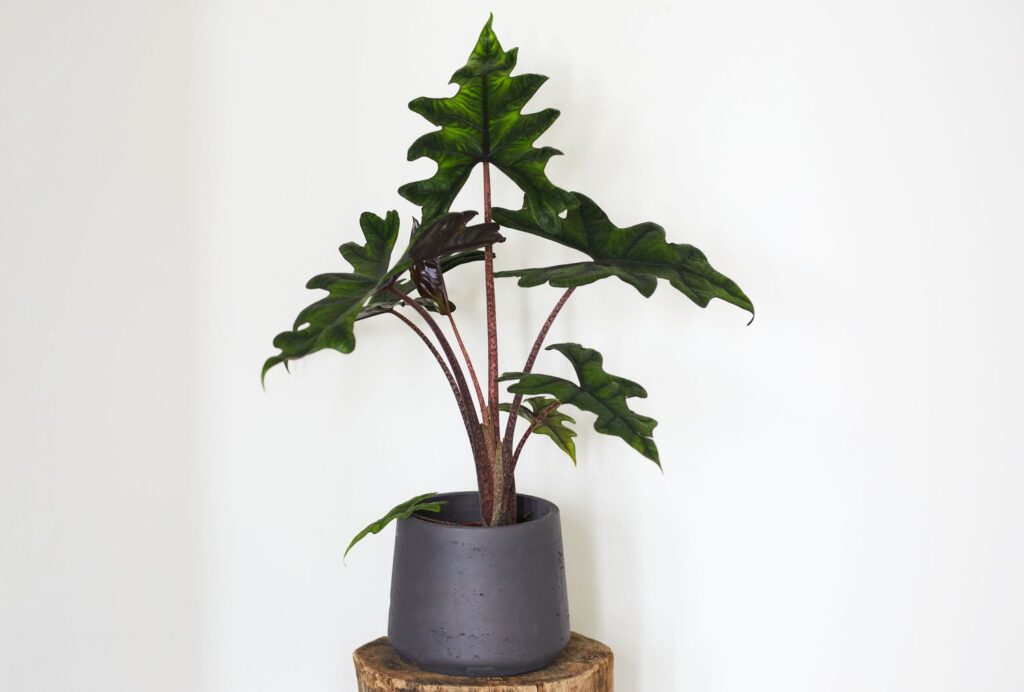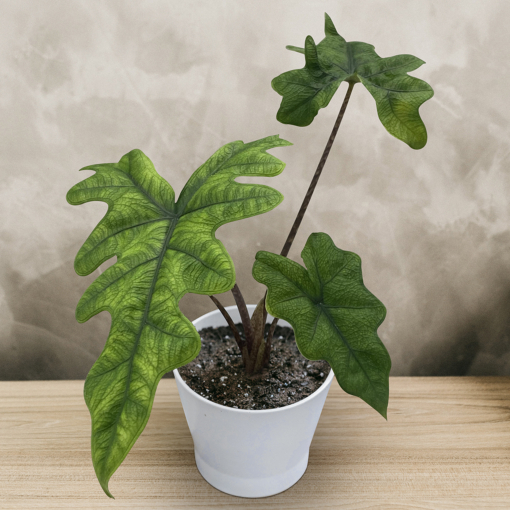Potting Your Alocasia Jacklyn: Best Times of the Year
Discover the beauty of Alocasia Jacklyn! This stunning plant adds a tropical touch to any space. Explore care tips and find yours today!

Introduction
Alocasia Jacklyn is a member of the Araceae family. It has taken the indoor gardening world by storm. This tropical beauty has striking foliage and a unique growth pattern. It is a favorite among enthusiasts and interior designers. Let’s explore what you need to know about the Alocasia Jacklyn.
Alocasia Jacklyn stands out among its peers for several reasons:
- Dramatic, arrow-shaped leaves
- Unique coloration and patterns
- Compact growth habit
- Adaptability to indoor environments
What is Alocasia Jacklyn?
Botanical Classification
Alocasia Jacklyn belongs to the genus Alocasia. It is part of the larger Araceae family. The scientific classification of Alocasia Jacklyn is as follows:
- Kingdom: Plantae
- Order: Alismatales
- Family: Araceae
- Genus: Alocasia
- Species: Alocasia Jacklyn
Its epithet “Jacklyn” is sometimes misspelled as “Jacklynn” or “Jacklin” in various sources.
Origin and Natural Habitat
Alocasia Jacklyn is native to the tropical regions of Southeast Asia.
- Malaysia
- Indonesia
- Parts of the Philippines
In its natural habitat, Alocasia Jacklyn thrives in the understory of tropical rainforests. Environments are characterized by:
- High humidity levels (often above 60%)
- Dappled sunlight filtered through the forest canopy
- Rich, well-draining soil with high organic content
- Consistent warm temperatures year-round
Distinctive Features of Alocasia Jacklyn
What sets Alocasia Jacklyn apart from other houseplants? Here are its unique and eye-catching features:
- Leaf Shape: The leaves are arrow-shaped (sagittate) with pronounced lobes at the base. They have a distinctive, almost shield-like appearance.
- Coloration: The foliage displays a striking contrast between dark green and silvery-white veins. It creates an intricate pattern that catches the eye.
- Texture: The leaves have a velvety texture.
- Compact Growth: The Alocasia Jacklyn has a manageable size, a height of 2-3 feet when mature.
- Petioles: The leaf stems (petioles) have a reddish or burgundy hue, and visual interest.
Growing Alocasia Jacklyn
Growing Alocasia Jacklyn requires replicating its natural habitat as much as possible. Let’s dive into the essential aspects of cultivating this beautiful plant.
Ideal Growing Conditions
1. Light Requirements
Alocasia Jacklyn thrives in bright, indirect light. Here’s what you need to know:
- Ideal location: Near an east or north-facing window
- Light intensity: 200-400 foot-candles
- Duration: 12-14 hours of indirect light daily
Warning: Direct sunlight can scorch the leaves, causing irreversible damage.
To ensure optimal light conditions:
- Use sheer curtains to filter strong sunlight
- Rotate the plant for even growth
- Consider artificial grow lights in low-light environments
2. Temperature and Humidity
Alocasia Jacklyn prefers warm, humid conditions reminiscent of its tropical origin:
- Temperature range: 65°F to 80°F (18°C to 27°C)
- Ideal humidity: 60-80%
To maintain these conditions:
- Use a humidifier or pebble tray to increase moisture
- Group plants together to create a microclimate
- Avoid placing near air conditioning vents or drafty areas
Tip: Watch humidity levels with a hygrometer for best results.
3. Soil Type and pH
The right soil mix is crucial for Alocasia Jacklyn’s health:
- Soil composition: Well-draining, rich in organic matter
- pH range: 5.5 to 6.5 (acidic)
Ideal soil mix recipe:
- 1 part peat moss or coco coir
- 1 part perlite or pumice
- 1 part orchid bark
- 1/2 part activated charcoal
This mix ensures:
- Excellent drainage
- Adequate aeration
- Moisture retention without waterlogging
Propagation Methods
Propagating Alocasia Jacklyn can be rewarding. Here are two effective methods:
1. Division
- Remove the plant from its pot
- Locate natural divisions or separate offsets with roots
- Separate the divisions using a clean, sharp knife
- Pot each division in fresh, well-draining soil
- Water and place in a warm, humid spot
Success rate: Approximately 80-90%
2. Stem Cuttings
- Select a healthy stem with at least one node
- Cut below the node with sterilized scissors
- Remove lower leaves, leaving 1-2 at the top
- Place the cutting in water or moist sphagnum moss
- Maintain warm temperatures (70-75°F) and high humidity
- Transplant once the roots are 1-2 inches long
Success rate: Approximately 60-70%
Potting and Repotting Alocasia Jacklyn
Proper potting is essential for healthy growth:
- Pot size: Choose a pot 1-2 inches larger than the root ball
- Material: Terracotta or ceramic pots with drainage holes
- Repotting frequency: Every 12-18 months or when root bound
Repotting steps:
- Water the plant 24 hours before repotting
- Remove from the current pot
- Inspect and trim any damaged roots
- Place in the new pot with fresh soil mix
- Water and place in a bright, indirect light
Caution: Avoid repotting during the dormant winter months.
Fertilizing Your Alocasia Jacklyn
A proper fertilization regimen supports lush growth:
- Frequency: Every 2-4 weeks during the growing season (spring and summer)
- Type: Balanced, water-soluble fertilizer (NPK ratio of 10-10-10 or 20-20-20)
- Dilution: Use at half the recommended strength to avoid fertilizer burn

Alocasia Jacklyn Care Guide
Care is crucial for maintaining the health and beauty of your Alocasia Jacklyn. This section will cover essential care practices to help your plant thrive.
Watering Schedule and Techniques
Watering Alocasia Jacklyn requires a delicate balance to avoid both overwatering and underwatering:
- Frequency: Water when the top 1-2 inches of soil feel dry
- Amount: Saturate the soil until water drains from the bottom
- Water quality: Use room temperature, filtered or distilled water
Best practices:
- Use the “soak and dry” method
- Water less in winter
- Avoid letting the plant sit in standing water
Pruning and Maintenance
Regular pruning helps maintain the plant’s shape and health:
- Remove yellowing or damaged leaves at the base of the stem
- Trim off any brown or crispy leaf edges
- Prune to control size and encourage bushier growth
- Clean leaves to remove dust and pests
Tools needed:
- Clean, sharp scissors or pruning shears
- Rubbing alcohol for sterilizing tools
Maintenance checklist:
- Dust leaves weekly with a damp cloth
- Check for pests
- Rotate plant quarterly for even growth
- Assess health monthly
Common Pests and Diseases
Alocasia Jacklyn can be susceptible to various pests and diseases:
Prevention and Treatment
Proactive measures:
- Maintain proper humidity and air circulation
- Inspect plants for early signs of issues
- Quarantine new plants before introducing them to your collection
Treatment options:
For pests:
- Isolate affected plants
- Remove visible pests with a cotton swab dipped in rubbing alcohol
- Apply neem oil or insecticidal soap every 7-10 days
- Use systemic insecticides for severe infestations
For diseases:
- Remove affected parts with sterilized tools
- Adjust watering practices to prevent overwatering
- Apply fungicides for fungal infections
- Improve air circulation around the plant
Natural pest control recipe:
- Mix 1tsp neem oil, 1tsp mild liquid soap, and 1 quart of warm water
- Spray on leaves every 7-10 days until pests are gone
Seasonal Care Tips for Alocasia Jacklyn
Adapting care to seasonal changes helps maintain optimal health:
Spring:
- Increase watering and fertilization
- Watch for new growth and adjust light exposure
- Begin propagation if desired
Summer:
- Provide extra humidity during hot, dry periods
- Protect from direct sunlight to prevent leaf burn
- Watch for increased pest activity
Fall:
- Reduce watering and fertilization as growth slows
- Prepare for winter dormancy by decreasing care intensity
- Consider supplemental lighting as days shorten
Winter:
- Maintain temperatures above 60°F (15°C)
- Water only when soil is dry
- Hold off on fertilization until spring
Year-round care reminder:
You’ll be well-equipped to keep your Alocasia Jacklyn healthy throughout the year. In the next section, we’ll address common problems and how to troubleshoot them.

VIII. Conclusion
As we wrap up our guide on Alocasia Jacklyn. Let’s recap the key points and final thoughts on this stunning tropical plant.
A. Recap of Key Points about Alocasia Jacklyn Care
Throughout this article, we’ve covered essential aspects of Alocasia Jacklyn care:
Light Requirements:
- Bright, indirect light is ideal
- Avoid direct sunlight to prevent leaf scorch
- 200-400 foot-candles of light for 12-14 hours daily
Temperature and Humidity:
- Optimal temperature range: 65°F to 80°F (18°C to 27°C)
- High humidity (60-80%) is crucial for healthy growth
Soil and Watering:
- Well-draining, organic-rich soil with a pH of 5.5 to 6.5
- Water when top 1-2 inches of soil are dry
- Adjust watering frequency
Fertilization:
- Use balanced, water-soluble fertilizer every 2-4 weeks during growing season
- Reduce or stop fertilization in fall and winter
Propagation:
- Division and stem cuttings are effective methods
- Best done during the active growing season
Pest and Disease Management:
- Regular inspection is key to early detection
- Common issues include spider mites, mealybugs, and root rot
- Use natural remedies or appropriate treatments
Seasonal Care:
- Adapt care routines to seasonal changes
- Reduce care intensity during winter dormancy
- Remember, the key to success with Alocasia Jacklyn is:
“Observe, adapt, and respond to your plant’s needs. Each Alocasia Jacklyn need slight adjustments to thrive in its specific environment.”
Tips for Success:
- Start with a healthy plant from a reputable source
- Be patient and consistent in your care routine
- Join online plant communities to share experiences and get advice
- Document your plant’s growth to track progress and identify care needs
Remember, every plant parent’s journey is unique. Patience, care, and the knowledge gained from this guide, equips you to grow an Alocasia Jacklyn.